Auditing and Assurance Assignment 1: Beta Limited Case Study
VerifiedAdded on 2023/06/04
|8
|2498
|326
Report
AI Summary
This assignment solution delves into various aspects of auditing and assurance, focusing on a case study involving Beta Limited. It analyzes audit risks associated with different scenarios, including product quality issues, segregation of duties, and employee theft. The report identifies material accounts affected and discusses the components of audit risk, particularly inherent and detection risks. Furthermore, it examines internal control weaknesses within the organization, proposes improvements, and evaluates the impact of these weaknesses on financial statement misstatements. The assignment also addresses the appropriate audit opinions to be issued under different circumstances, such as limitations in scope or going concern issues. Finally, it outlines the auditor's responsibilities regarding events occurring after the balance sheet date, including contract signings, patent applications, reported fraud, and accounts receivable collectability.
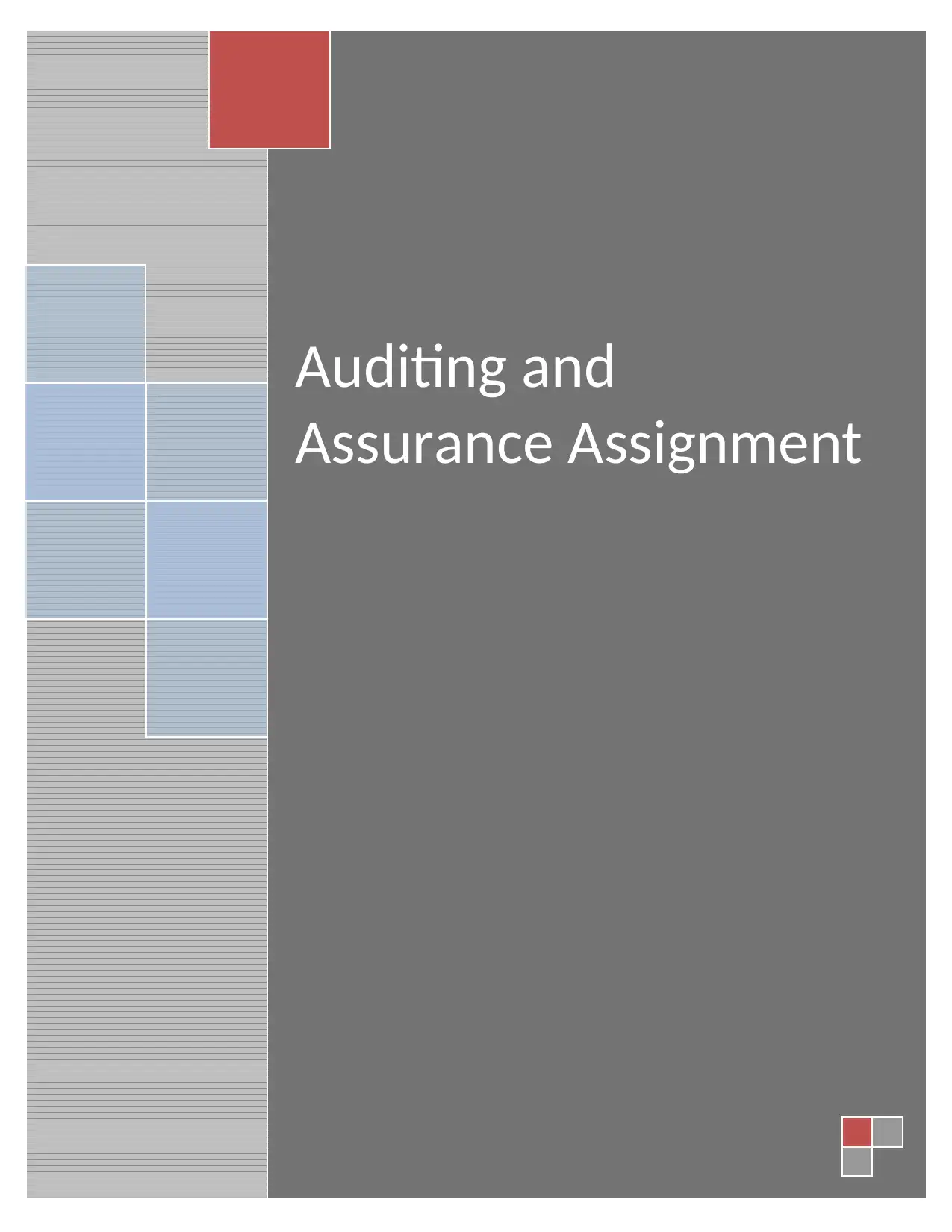
Auditing and
Assurance Assignment
Assurance Assignment
Paraphrase This Document
Need a fresh take? Get an instant paraphrase of this document with our AI Paraphraser
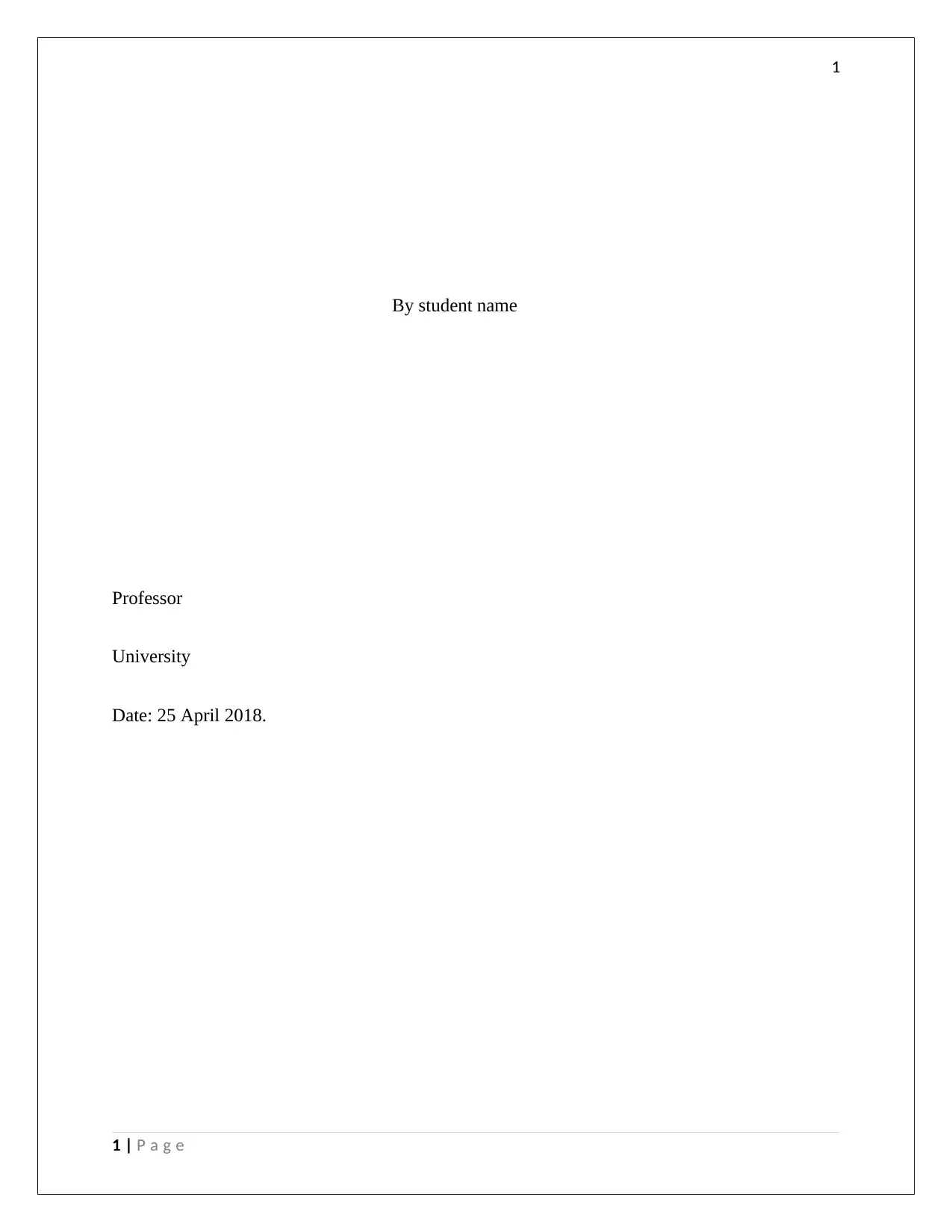
1
By student name
Professor
University
Date: 25 April 2018.
1 | P a g e
By student name
Professor
University
Date: 25 April 2018.
1 | P a g e
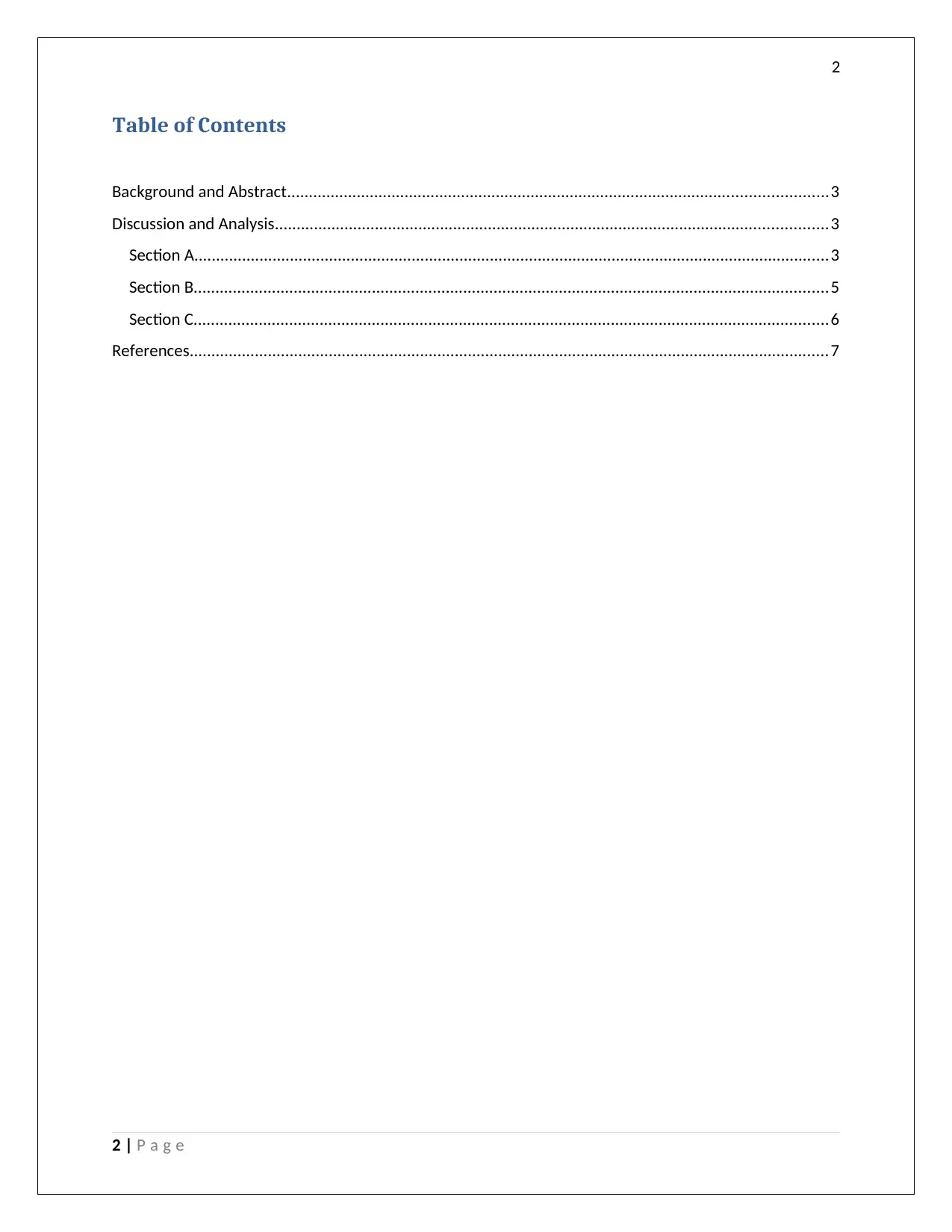
2
Table of Contents
Background and Abstract............................................................................................................................3
Discussion and Analysis...............................................................................................................................3
Section A..................................................................................................................................................3
Section B..................................................................................................................................................5
Section C..................................................................................................................................................6
References...................................................................................................................................................7
2 | P a g e
Table of Contents
Background and Abstract............................................................................................................................3
Discussion and Analysis...............................................................................................................................3
Section A..................................................................................................................................................3
Section B..................................................................................................................................................5
Section C..................................................................................................................................................6
References...................................................................................................................................................7
2 | P a g e
⊘ This is a preview!⊘
Do you want full access?
Subscribe today to unlock all pages.

Trusted by 1+ million students worldwide
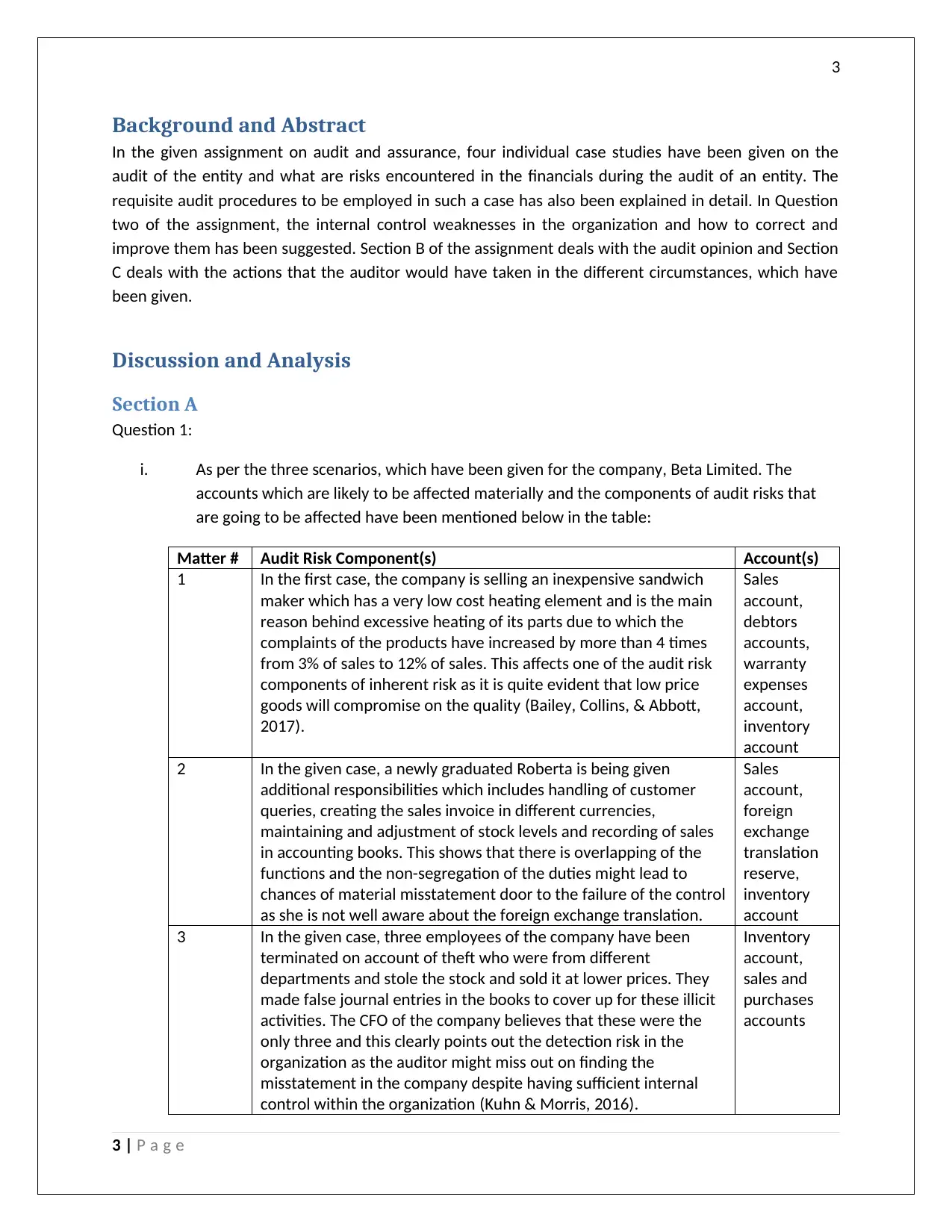
3
Background and Abstract
In the given assignment on audit and assurance, four individual case studies have been given on the
audit of the entity and what are risks encountered in the financials during the audit of an entity. The
requisite audit procedures to be employed in such a case has also been explained in detail. In Question
two of the assignment, the internal control weaknesses in the organization and how to correct and
improve them has been suggested. Section B of the assignment deals with the audit opinion and Section
C deals with the actions that the auditor would have taken in the different circumstances, which have
been given.
Discussion and Analysis
Section A
Question 1:
i. As per the three scenarios, which have been given for the company, Beta Limited. The
accounts which are likely to be affected materially and the components of audit risks that
are going to be affected have been mentioned below in the table:
Matter # Audit Risk Component(s) Account(s)
1 In the first case, the company is selling an inexpensive sandwich
maker which has a very low cost heating element and is the main
reason behind excessive heating of its parts due to which the
complaints of the products have increased by more than 4 times
from 3% of sales to 12% of sales. This affects one of the audit risk
components of inherent risk as it is quite evident that low price
goods will compromise on the quality (Bailey, Collins, & Abbott,
2017).
Sales
account,
debtors
accounts,
warranty
expenses
account,
inventory
account
2 In the given case, a newly graduated Roberta is being given
additional responsibilities which includes handling of customer
queries, creating the sales invoice in different currencies,
maintaining and adjustment of stock levels and recording of sales
in accounting books. This shows that there is overlapping of the
functions and the non-segregation of the duties might lead to
chances of material misstatement door to the failure of the control
as she is not well aware about the foreign exchange translation.
Sales
account,
foreign
exchange
translation
reserve,
inventory
account
3 In the given case, three employees of the company have been
terminated on account of theft who were from different
departments and stole the stock and sold it at lower prices. They
made false journal entries in the books to cover up for these illicit
activities. The CFO of the company believes that these were the
only three and this clearly points out the detection risk in the
organization as the auditor might miss out on finding the
misstatement in the company despite having sufficient internal
control within the organization (Kuhn & Morris, 2016).
Inventory
account,
sales and
purchases
accounts
3 | P a g e
Background and Abstract
In the given assignment on audit and assurance, four individual case studies have been given on the
audit of the entity and what are risks encountered in the financials during the audit of an entity. The
requisite audit procedures to be employed in such a case has also been explained in detail. In Question
two of the assignment, the internal control weaknesses in the organization and how to correct and
improve them has been suggested. Section B of the assignment deals with the audit opinion and Section
C deals with the actions that the auditor would have taken in the different circumstances, which have
been given.
Discussion and Analysis
Section A
Question 1:
i. As per the three scenarios, which have been given for the company, Beta Limited. The
accounts which are likely to be affected materially and the components of audit risks that
are going to be affected have been mentioned below in the table:
Matter # Audit Risk Component(s) Account(s)
1 In the first case, the company is selling an inexpensive sandwich
maker which has a very low cost heating element and is the main
reason behind excessive heating of its parts due to which the
complaints of the products have increased by more than 4 times
from 3% of sales to 12% of sales. This affects one of the audit risk
components of inherent risk as it is quite evident that low price
goods will compromise on the quality (Bailey, Collins, & Abbott,
2017).
Sales
account,
debtors
accounts,
warranty
expenses
account,
inventory
account
2 In the given case, a newly graduated Roberta is being given
additional responsibilities which includes handling of customer
queries, creating the sales invoice in different currencies,
maintaining and adjustment of stock levels and recording of sales
in accounting books. This shows that there is overlapping of the
functions and the non-segregation of the duties might lead to
chances of material misstatement door to the failure of the control
as she is not well aware about the foreign exchange translation.
Sales
account,
foreign
exchange
translation
reserve,
inventory
account
3 In the given case, three employees of the company have been
terminated on account of theft who were from different
departments and stole the stock and sold it at lower prices. They
made false journal entries in the books to cover up for these illicit
activities. The CFO of the company believes that these were the
only three and this clearly points out the detection risk in the
organization as the auditor might miss out on finding the
misstatement in the company despite having sufficient internal
control within the organization (Kuhn & Morris, 2016).
Inventory
account,
sales and
purchases
accounts
3 | P a g e
Paraphrase This Document
Need a fresh take? Get an instant paraphrase of this document with our AI Paraphraser
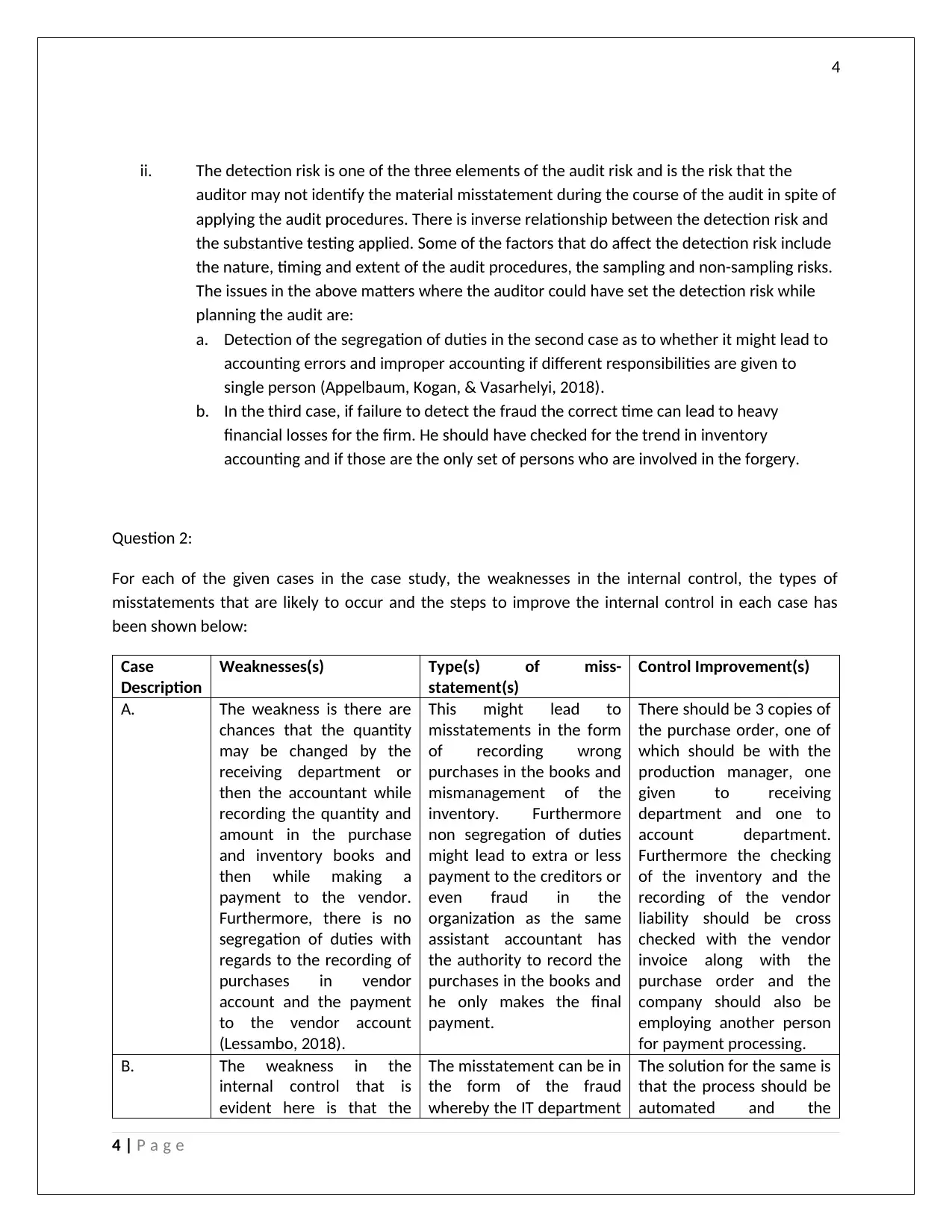
4
ii. The detection risk is one of the three elements of the audit risk and is the risk that the
auditor may not identify the material misstatement during the course of the audit in spite of
applying the audit procedures. There is inverse relationship between the detection risk and
the substantive testing applied. Some of the factors that do affect the detection risk include
the nature, timing and extent of the audit procedures, the sampling and non-sampling risks.
The issues in the above matters where the auditor could have set the detection risk while
planning the audit are:
a. Detection of the segregation of duties in the second case as to whether it might lead to
accounting errors and improper accounting if different responsibilities are given to
single person (Appelbaum, Kogan, & Vasarhelyi, 2018).
b. In the third case, if failure to detect the fraud the correct time can lead to heavy
financial losses for the firm. He should have checked for the trend in inventory
accounting and if those are the only set of persons who are involved in the forgery.
Question 2:
For each of the given cases in the case study, the weaknesses in the internal control, the types of
misstatements that are likely to occur and the steps to improve the internal control in each case has
been shown below:
Case
Description
Weaknesses(s) Type(s) of miss-
statement(s)
Control Improvement(s)
A. The weakness is there are
chances that the quantity
may be changed by the
receiving department or
then the accountant while
recording the quantity and
amount in the purchase
and inventory books and
then while making a
payment to the vendor.
Furthermore, there is no
segregation of duties with
regards to the recording of
purchases in vendor
account and the payment
to the vendor account
(Lessambo, 2018).
This might lead to
misstatements in the form
of recording wrong
purchases in the books and
mismanagement of the
inventory. Furthermore
non segregation of duties
might lead to extra or less
payment to the creditors or
even fraud in the
organization as the same
assistant accountant has
the authority to record the
purchases in the books and
he only makes the final
payment.
There should be 3 copies of
the purchase order, one of
which should be with the
production manager, one
given to receiving
department and one to
account department.
Furthermore the checking
of the inventory and the
recording of the vendor
liability should be cross
checked with the vendor
invoice along with the
purchase order and the
company should also be
employing another person
for payment processing.
B. The weakness in the
internal control that is
evident here is that the
The misstatement can be in
the form of the fraud
whereby the IT department
The solution for the same is
that the process should be
automated and the
4 | P a g e
ii. The detection risk is one of the three elements of the audit risk and is the risk that the
auditor may not identify the material misstatement during the course of the audit in spite of
applying the audit procedures. There is inverse relationship between the detection risk and
the substantive testing applied. Some of the factors that do affect the detection risk include
the nature, timing and extent of the audit procedures, the sampling and non-sampling risks.
The issues in the above matters where the auditor could have set the detection risk while
planning the audit are:
a. Detection of the segregation of duties in the second case as to whether it might lead to
accounting errors and improper accounting if different responsibilities are given to
single person (Appelbaum, Kogan, & Vasarhelyi, 2018).
b. In the third case, if failure to detect the fraud the correct time can lead to heavy
financial losses for the firm. He should have checked for the trend in inventory
accounting and if those are the only set of persons who are involved in the forgery.
Question 2:
For each of the given cases in the case study, the weaknesses in the internal control, the types of
misstatements that are likely to occur and the steps to improve the internal control in each case has
been shown below:
Case
Description
Weaknesses(s) Type(s) of miss-
statement(s)
Control Improvement(s)
A. The weakness is there are
chances that the quantity
may be changed by the
receiving department or
then the accountant while
recording the quantity and
amount in the purchase
and inventory books and
then while making a
payment to the vendor.
Furthermore, there is no
segregation of duties with
regards to the recording of
purchases in vendor
account and the payment
to the vendor account
(Lessambo, 2018).
This might lead to
misstatements in the form
of recording wrong
purchases in the books and
mismanagement of the
inventory. Furthermore
non segregation of duties
might lead to extra or less
payment to the creditors or
even fraud in the
organization as the same
assistant accountant has
the authority to record the
purchases in the books and
he only makes the final
payment.
There should be 3 copies of
the purchase order, one of
which should be with the
production manager, one
given to receiving
department and one to
account department.
Furthermore the checking
of the inventory and the
recording of the vendor
liability should be cross
checked with the vendor
invoice along with the
purchase order and the
company should also be
employing another person
for payment processing.
B. The weakness in the
internal control that is
evident here is that the
The misstatement can be in
the form of the fraud
whereby the IT department
The solution for the same is
that the process should be
automated and the
4 | P a g e
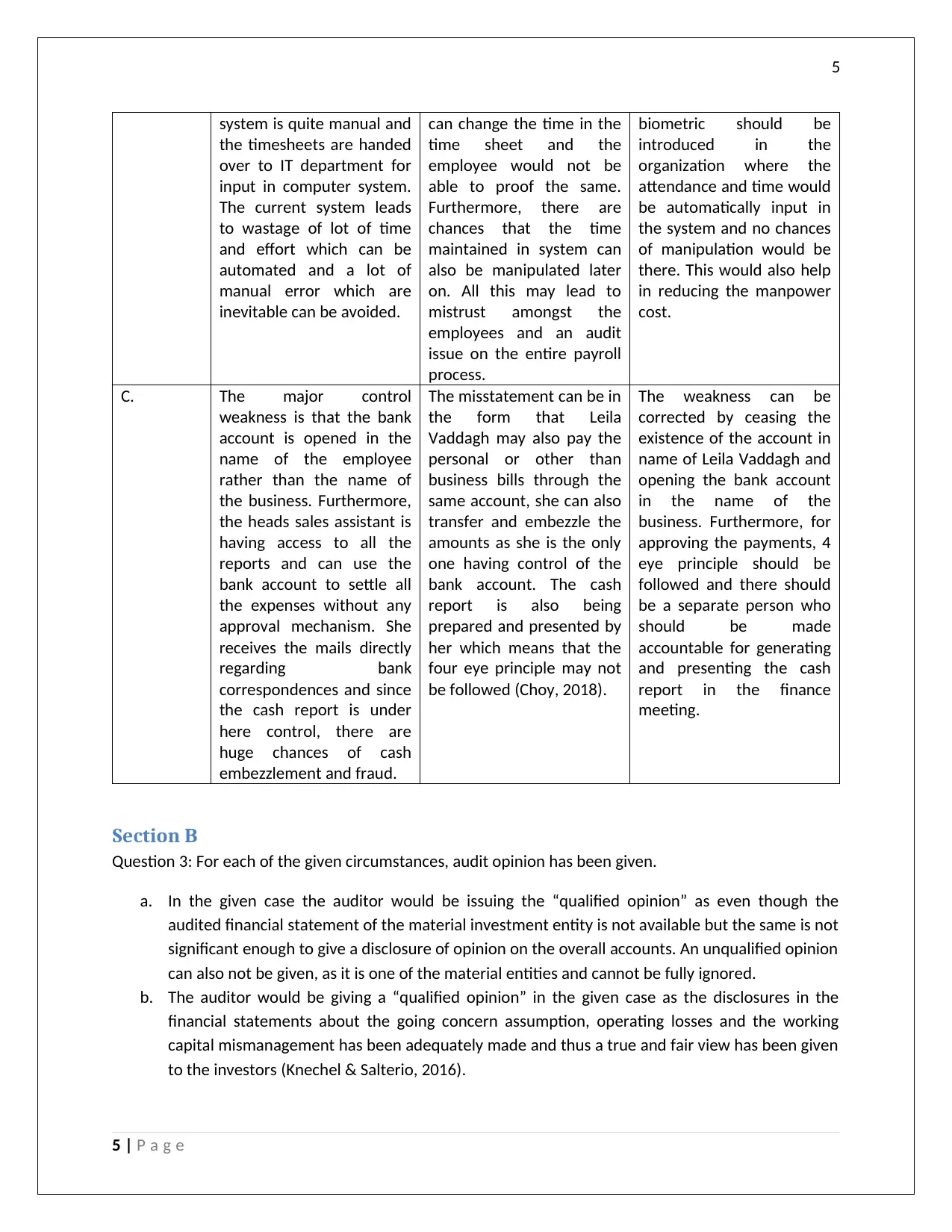
5
system is quite manual and
the timesheets are handed
over to IT department for
input in computer system.
The current system leads
to wastage of lot of time
and effort which can be
automated and a lot of
manual error which are
inevitable can be avoided.
can change the time in the
time sheet and the
employee would not be
able to proof the same.
Furthermore, there are
chances that the time
maintained in system can
also be manipulated later
on. All this may lead to
mistrust amongst the
employees and an audit
issue on the entire payroll
process.
biometric should be
introduced in the
organization where the
attendance and time would
be automatically input in
the system and no chances
of manipulation would be
there. This would also help
in reducing the manpower
cost.
C. The major control
weakness is that the bank
account is opened in the
name of the employee
rather than the name of
the business. Furthermore,
the heads sales assistant is
having access to all the
reports and can use the
bank account to settle all
the expenses without any
approval mechanism. She
receives the mails directly
regarding bank
correspondences and since
the cash report is under
here control, there are
huge chances of cash
embezzlement and fraud.
The misstatement can be in
the form that Leila
Vaddagh may also pay the
personal or other than
business bills through the
same account, she can also
transfer and embezzle the
amounts as she is the only
one having control of the
bank account. The cash
report is also being
prepared and presented by
her which means that the
four eye principle may not
be followed (Choy, 2018).
The weakness can be
corrected by ceasing the
existence of the account in
name of Leila Vaddagh and
opening the bank account
in the name of the
business. Furthermore, for
approving the payments, 4
eye principle should be
followed and there should
be a separate person who
should be made
accountable for generating
and presenting the cash
report in the finance
meeting.
Section B
Question 3: For each of the given circumstances, audit opinion has been given.
a. In the given case the auditor would be issuing the “qualified opinion” as even though the
audited financial statement of the material investment entity is not available but the same is not
significant enough to give a disclosure of opinion on the overall accounts. An unqualified opinion
can also not be given, as it is one of the material entities and cannot be fully ignored.
b. The auditor would be giving a “qualified opinion” in the given case as the disclosures in the
financial statements about the going concern assumption, operating losses and the working
capital mismanagement has been adequately made and thus a true and fair view has been given
to the investors (Knechel & Salterio, 2016).
5 | P a g e
system is quite manual and
the timesheets are handed
over to IT department for
input in computer system.
The current system leads
to wastage of lot of time
and effort which can be
automated and a lot of
manual error which are
inevitable can be avoided.
can change the time in the
time sheet and the
employee would not be
able to proof the same.
Furthermore, there are
chances that the time
maintained in system can
also be manipulated later
on. All this may lead to
mistrust amongst the
employees and an audit
issue on the entire payroll
process.
biometric should be
introduced in the
organization where the
attendance and time would
be automatically input in
the system and no chances
of manipulation would be
there. This would also help
in reducing the manpower
cost.
C. The major control
weakness is that the bank
account is opened in the
name of the employee
rather than the name of
the business. Furthermore,
the heads sales assistant is
having access to all the
reports and can use the
bank account to settle all
the expenses without any
approval mechanism. She
receives the mails directly
regarding bank
correspondences and since
the cash report is under
here control, there are
huge chances of cash
embezzlement and fraud.
The misstatement can be in
the form that Leila
Vaddagh may also pay the
personal or other than
business bills through the
same account, she can also
transfer and embezzle the
amounts as she is the only
one having control of the
bank account. The cash
report is also being
prepared and presented by
her which means that the
four eye principle may not
be followed (Choy, 2018).
The weakness can be
corrected by ceasing the
existence of the account in
name of Leila Vaddagh and
opening the bank account
in the name of the
business. Furthermore, for
approving the payments, 4
eye principle should be
followed and there should
be a separate person who
should be made
accountable for generating
and presenting the cash
report in the finance
meeting.
Section B
Question 3: For each of the given circumstances, audit opinion has been given.
a. In the given case the auditor would be issuing the “qualified opinion” as even though the
audited financial statement of the material investment entity is not available but the same is not
significant enough to give a disclosure of opinion on the overall accounts. An unqualified opinion
can also not be given, as it is one of the material entities and cannot be fully ignored.
b. The auditor would be giving a “qualified opinion” in the given case as the disclosures in the
financial statements about the going concern assumption, operating losses and the working
capital mismanagement has been adequately made and thus a true and fair view has been given
to the investors (Knechel & Salterio, 2016).
5 | P a g e
⊘ This is a preview!⊘
Do you want full access?
Subscribe today to unlock all pages.

Trusted by 1+ million students worldwide
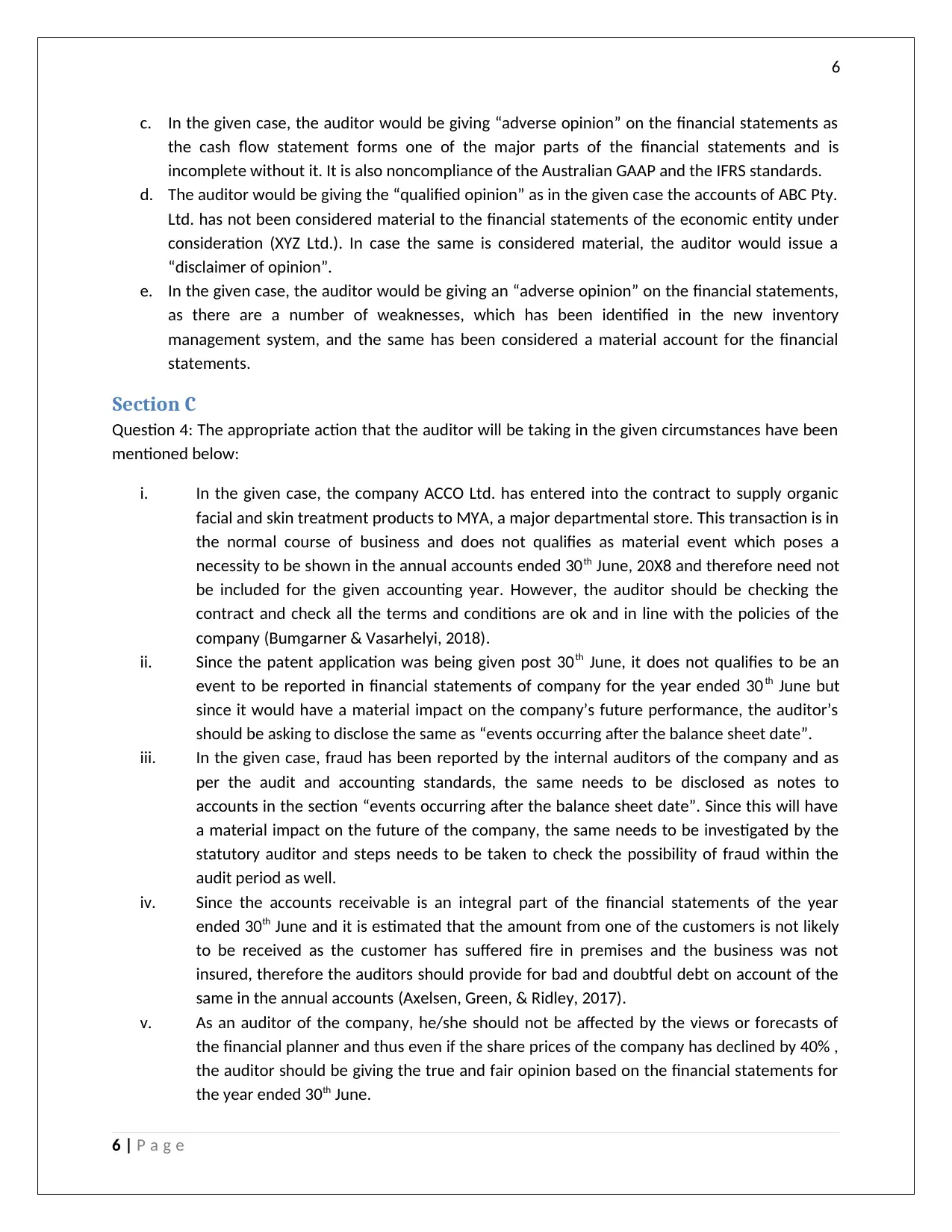
6
c. In the given case, the auditor would be giving “adverse opinion” on the financial statements as
the cash flow statement forms one of the major parts of the financial statements and is
incomplete without it. It is also noncompliance of the Australian GAAP and the IFRS standards.
d. The auditor would be giving the “qualified opinion” as in the given case the accounts of ABC Pty.
Ltd. has not been considered material to the financial statements of the economic entity under
consideration (XYZ Ltd.). In case the same is considered material, the auditor would issue a
“disclaimer of opinion”.
e. In the given case, the auditor would be giving an “adverse opinion” on the financial statements,
as there are a number of weaknesses, which has been identified in the new inventory
management system, and the same has been considered a material account for the financial
statements.
Section C
Question 4: The appropriate action that the auditor will be taking in the given circumstances have been
mentioned below:
i. In the given case, the company ACCO Ltd. has entered into the contract to supply organic
facial and skin treatment products to MYA, a major departmental store. This transaction is in
the normal course of business and does not qualifies as material event which poses a
necessity to be shown in the annual accounts ended 30th June, 20X8 and therefore need not
be included for the given accounting year. However, the auditor should be checking the
contract and check all the terms and conditions are ok and in line with the policies of the
company (Bumgarner & Vasarhelyi, 2018).
ii. Since the patent application was being given post 30th June, it does not qualifies to be an
event to be reported in financial statements of company for the year ended 30 th June but
since it would have a material impact on the company’s future performance, the auditor’s
should be asking to disclose the same as “events occurring after the balance sheet date”.
iii. In the given case, fraud has been reported by the internal auditors of the company and as
per the audit and accounting standards, the same needs to be disclosed as notes to
accounts in the section “events occurring after the balance sheet date”. Since this will have
a material impact on the future of the company, the same needs to be investigated by the
statutory auditor and steps needs to be taken to check the possibility of fraud within the
audit period as well.
iv. Since the accounts receivable is an integral part of the financial statements of the year
ended 30th June and it is estimated that the amount from one of the customers is not likely
to be received as the customer has suffered fire in premises and the business was not
insured, therefore the auditors should provide for bad and doubtful debt on account of the
same in the annual accounts (Axelsen, Green, & Ridley, 2017).
v. As an auditor of the company, he/she should not be affected by the views or forecasts of
the financial planner and thus even if the share prices of the company has declined by 40% ,
the auditor should be giving the true and fair opinion based on the financial statements for
the year ended 30th June.
6 | P a g e
c. In the given case, the auditor would be giving “adverse opinion” on the financial statements as
the cash flow statement forms one of the major parts of the financial statements and is
incomplete without it. It is also noncompliance of the Australian GAAP and the IFRS standards.
d. The auditor would be giving the “qualified opinion” as in the given case the accounts of ABC Pty.
Ltd. has not been considered material to the financial statements of the economic entity under
consideration (XYZ Ltd.). In case the same is considered material, the auditor would issue a
“disclaimer of opinion”.
e. In the given case, the auditor would be giving an “adverse opinion” on the financial statements,
as there are a number of weaknesses, which has been identified in the new inventory
management system, and the same has been considered a material account for the financial
statements.
Section C
Question 4: The appropriate action that the auditor will be taking in the given circumstances have been
mentioned below:
i. In the given case, the company ACCO Ltd. has entered into the contract to supply organic
facial and skin treatment products to MYA, a major departmental store. This transaction is in
the normal course of business and does not qualifies as material event which poses a
necessity to be shown in the annual accounts ended 30th June, 20X8 and therefore need not
be included for the given accounting year. However, the auditor should be checking the
contract and check all the terms and conditions are ok and in line with the policies of the
company (Bumgarner & Vasarhelyi, 2018).
ii. Since the patent application was being given post 30th June, it does not qualifies to be an
event to be reported in financial statements of company for the year ended 30 th June but
since it would have a material impact on the company’s future performance, the auditor’s
should be asking to disclose the same as “events occurring after the balance sheet date”.
iii. In the given case, fraud has been reported by the internal auditors of the company and as
per the audit and accounting standards, the same needs to be disclosed as notes to
accounts in the section “events occurring after the balance sheet date”. Since this will have
a material impact on the future of the company, the same needs to be investigated by the
statutory auditor and steps needs to be taken to check the possibility of fraud within the
audit period as well.
iv. Since the accounts receivable is an integral part of the financial statements of the year
ended 30th June and it is estimated that the amount from one of the customers is not likely
to be received as the customer has suffered fire in premises and the business was not
insured, therefore the auditors should provide for bad and doubtful debt on account of the
same in the annual accounts (Axelsen, Green, & Ridley, 2017).
v. As an auditor of the company, he/she should not be affected by the views or forecasts of
the financial planner and thus even if the share prices of the company has declined by 40% ,
the auditor should be giving the true and fair opinion based on the financial statements for
the year ended 30th June.
6 | P a g e
Paraphrase This Document
Need a fresh take? Get an instant paraphrase of this document with our AI Paraphraser
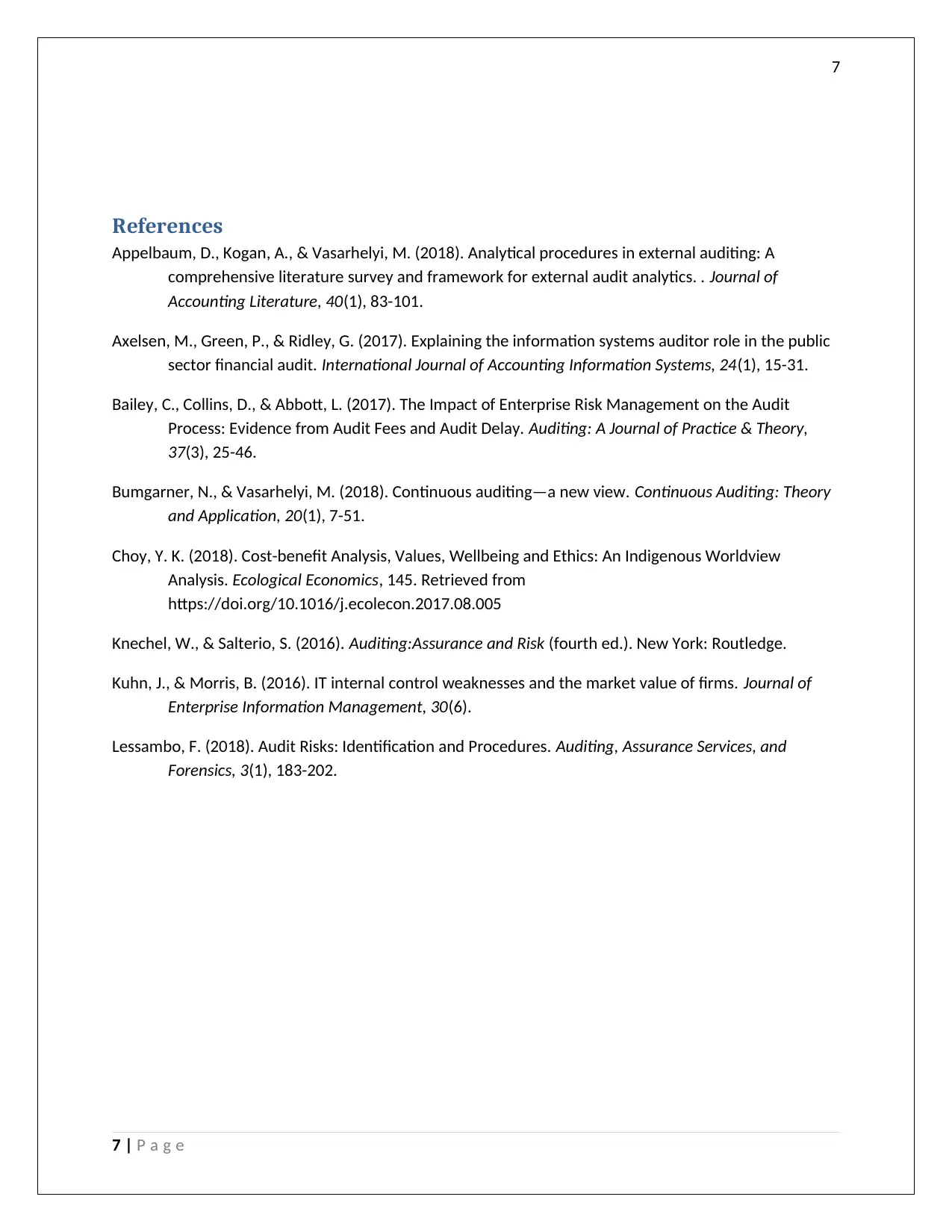
7
References
Appelbaum, D., Kogan, A., & Vasarhelyi, M. (2018). Analytical procedures in external auditing: A
comprehensive literature survey and framework for external audit analytics. . Journal of
Accounting Literature, 40(1), 83-101.
Axelsen, M., Green, P., & Ridley, G. (2017). Explaining the information systems auditor role in the public
sector financial audit. International Journal of Accounting Information Systems, 24(1), 15-31.
Bailey, C., Collins, D., & Abbott, L. (2017). The Impact of Enterprise Risk Management on the Audit
Process: Evidence from Audit Fees and Audit Delay. Auditing: A Journal of Practice & Theory,
37(3), 25-46.
Bumgarner, N., & Vasarhelyi, M. (2018). Continuous auditing—a new view. Continuous Auditing: Theory
and Application, 20(1), 7-51.
Choy, Y. K. (2018). Cost-benefit Analysis, Values, Wellbeing and Ethics: An Indigenous Worldview
Analysis. Ecological Economics, 145. Retrieved from
https://doi.org/10.1016/j.ecolecon.2017.08.005
Knechel, W., & Salterio, S. (2016). Auditing:Assurance and Risk (fourth ed.). New York: Routledge.
Kuhn, J., & Morris, B. (2016). IT internal control weaknesses and the market value of firms. Journal of
Enterprise Information Management, 30(6).
Lessambo, F. (2018). Audit Risks: Identification and Procedures. Auditing, Assurance Services, and
Forensics, 3(1), 183-202.
7 | P a g e
References
Appelbaum, D., Kogan, A., & Vasarhelyi, M. (2018). Analytical procedures in external auditing: A
comprehensive literature survey and framework for external audit analytics. . Journal of
Accounting Literature, 40(1), 83-101.
Axelsen, M., Green, P., & Ridley, G. (2017). Explaining the information systems auditor role in the public
sector financial audit. International Journal of Accounting Information Systems, 24(1), 15-31.
Bailey, C., Collins, D., & Abbott, L. (2017). The Impact of Enterprise Risk Management on the Audit
Process: Evidence from Audit Fees and Audit Delay. Auditing: A Journal of Practice & Theory,
37(3), 25-46.
Bumgarner, N., & Vasarhelyi, M. (2018). Continuous auditing—a new view. Continuous Auditing: Theory
and Application, 20(1), 7-51.
Choy, Y. K. (2018). Cost-benefit Analysis, Values, Wellbeing and Ethics: An Indigenous Worldview
Analysis. Ecological Economics, 145. Retrieved from
https://doi.org/10.1016/j.ecolecon.2017.08.005
Knechel, W., & Salterio, S. (2016). Auditing:Assurance and Risk (fourth ed.). New York: Routledge.
Kuhn, J., & Morris, B. (2016). IT internal control weaknesses and the market value of firms. Journal of
Enterprise Information Management, 30(6).
Lessambo, F. (2018). Audit Risks: Identification and Procedures. Auditing, Assurance Services, and
Forensics, 3(1), 183-202.
7 | P a g e
1 out of 8
Related Documents
Your All-in-One AI-Powered Toolkit for Academic Success.
+13062052269
info@desklib.com
Available 24*7 on WhatsApp / Email
![[object Object]](/_next/static/media/star-bottom.7253800d.svg)
Unlock your academic potential
Copyright © 2020–2025 A2Z Services. All Rights Reserved. Developed and managed by ZUCOL.





